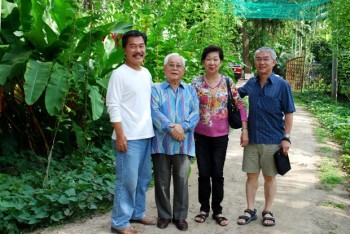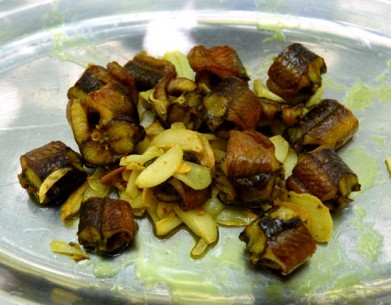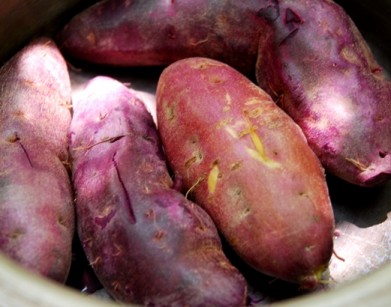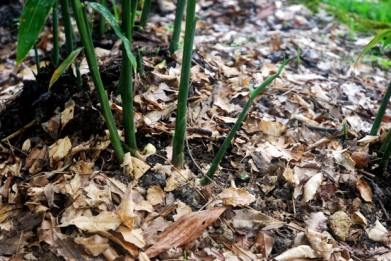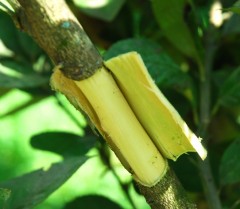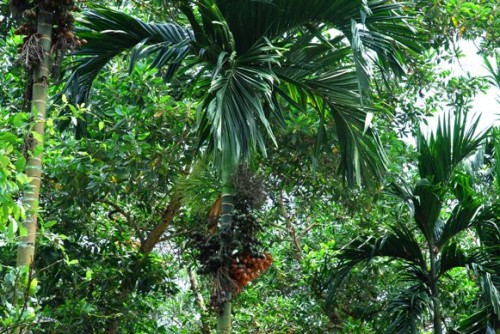Jun 21, 2011
Surprise Visitor
A surprise distinguished visitor dropped by.
Tan Sri Tan Lai Kim, Puan Sri and son, Edmund
It is always a pleasure to see successful developers who are also into sustainability.
18:25 Posted in Visitors | Permalink | Comments (2) | Tags: tan lai kim group of companies, tan sri tan lai kim, palm grove, capital land, cheras hartamas
They lose all sense of fear....
If we truly mean them no harm, they lose all sense of fear....
They will nest anywhere, here, in a serai (lemongrass) bed
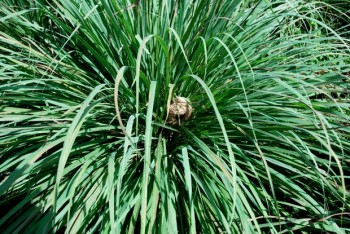
Close up of the nest in a serai (lemongrass) clump.
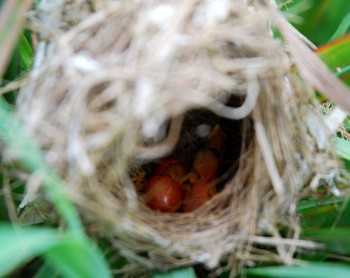
Three red eggs hatching out. The color of the new hatchlings the same red as the eggs. We have yet to id the bird.

A crested lizard with a more turquoise coloring than the normal green. It's more curious than fearful of our hand. Occasionally they will just land on your head or shoulder as you walk under a tree. The farm is a sanctuary of sorts for them and other lizards.
PS found this old pic demonstrating what we mean:

Curious visitor from the tree under which we were having lunch
14:30 Posted in Blog | Permalink | Comments (0) | Tags: wild birds, taming wild birds, green crested lizard
Jun 05, 2011
Spreading the word....
Our workers come from distant villages in the Himalayas. They come of course to earn much needed hard cash. But more than that we make sure they return home with new knowledge and skills to increase productivity without resorting to chemicals. When they achieve competency in a specific area, they get a certificate. Our farm have a long list of Nepalese who want to work for us.
Here's Santa Kumar receiving his competency certificates from Pak Cik Razaly the farm manager. Looking on is the farm supervisor, Dilli Prasad.
Santa received his certificates in composting and in marcotting.
He showed that he could independently produce compost on a schedule so that supply is never cut off. He could ensure that temperatures are reached so that pathogens are destroyed. He always gets the carbon: nitrogen ratio right.
Certificate in composting
He does marcotting of fruit trees independently with no supervision and has close to 100% success.
Certificate in Marcotting
We award certificates for competency in a wide range of farm work – from taking care of specific crops, for example, sweet potatoes, spinach, etc., to making high quality cement posts, to poultry necropsy and disease identification.
When they return to Nepal, they can either be better farmers, or they can use the certificates to train others or to earn better wages from their next employer.
08:56 Posted in Blog, Permaculture | Permalink | Comments (2) | Tags: training, certificate in organic farming, dq farm, knowledge based farming
May 27, 2011
A Good Axe is also Permaculture?
A quality durable axe, quaranteed for 20 years will mean "we take less, that we need to produce less, destroy less". That's permaculture! That's the antithesis to modern unsustainable consumer driven economy (think branded running shoes that lasts only a few months).
We received these axes which are quaranteed for 20 years, recently
These are from Gransfors Bruks, Sweden. The quote above is from their Axe Book. Permaculture in Manufacturing - PermaFacture perhaps!
We got a splitting maul, a splitting wedge, and a felling axe.
The axe-smith who made our axes is UN or Ulrik Nilsson. Here's his picture from the Axe Book:

We took the axes for a test recently. The Nepalese who are regular axe users say they are the best axes they have ever used in terms of balance, conservation of energy, etc.
Pak Cik Razaly had an interesting question: why can't we make such axes? Why indeed.
Dilli, our Nepalese supervisor, trying out the maul.
Pak Cik Razaly felling this 8 inch trunk without breaking a sweat. Have you tried a China-made axe?
Thanks to Lrong Lim in Takamatsu, Japan for writing about his Gransfors Bruks axe in his blog: http://lronglim.blogspot.com/
This is Gransfors Bruks' website: http://www.gransfors.com. Email is yxboken@gransfors.com.
P.S. The axes took 5 days to arrive in KLIA from Sweden (after waiting a couple of months for them to be forged). They took 9 days to travel from KLIA to our office in KL, a distance of 50 km.
16:35 Posted in Blog, Permaculture | Permalink | Comments (4) | Tags: grunsfors axes, lrong lim, american felling axe, splitting maul
Apr 25, 2011
Lunch At the Farm
The sweet potatoes are ready for harvest just 70 days after planting. That's fast, and they achieved a good size too.
We decided to have a quick lunch - plain steamed sweet potatoes, and a wild eel that was wriggling across our path as we were inspecting the sweet potatoes.
Wild eel rubbed in some kunyit (turmeric), stir-fried in grassfed chicken fat with garlic. Those of you who know good food can imagine just how delicious this dish is!
Purple and yellow sweet potatoes for their antioxidant (anthocyanin), their high fibre, and their ability to keep blood sugar levels stable ( they are a source of natural 'caiapo', a supplement for the diabetic to control blood sugar ).
To add an exotic gourmet touch to the plain steamed potato, make a dry topping of grated coconut, sugar and salt to taste. Sprinkle over bite-size sweet potato, or spoon on top of each chunky slice.
Postscript: This huge guy crossed our path a few days later. Our experiment to create a sustainable mini-scale natural fishery by slowing down sections of the stream, feeding, etc seems to be producing result.
Click on pic for close - up
12:13 Posted in Blog | Permalink | Comments (8) | Tags: eel, wild eel, sweet potato, purple sweet potato, anthocyanin, caiapo, diabetic food, diabetic superfood, slow food
Apr 13, 2011
Permaculture At The Farm II
Here are more examples of permaculture (permanent agriculture) at the farm:
Mulching to reduce water loss. Previously we advocated sheet mulching (to reduce weeds, etc ) with cardboard and other cellulose based material. DON'T DO IT! Termites love these heavy cellulose material. Mulching in humid Malaysia should be light to avoid termites and fungal problems. Leguminous cover crop as living mulch is a better idea.

Multi-crop and companion planting of gingers, chilies, sweet potatoes, water melon and passion fruits on raised beds. Permaculture is antithetical to mono-cropping (think oil palm, or think dragon fruit farms; organic or otherwise). On a small farm level, mono-cropping often leads to increasing dependence on chemicals and crops are often decimated suddenly by disease. The recent demise of many dragon fruit farms, both conventional and organic, is one example.
Serai or lemon grass on raised beds with sweet potato as living mulch and companion. Once the sweet potatoes are harvested, leguminous cover crop will be planted to revitalise the soil.

A low maintenance food garden grown entirely on used tires on low yield soggy, clayey soil. Practically no weeding is needed and monthly dressing of compost is all that's needed to produce sweet potatoes, curcuma mangga, lempoyang, kunyit and common ginger.

A 3000 sq ft food forest with very low maintenance, fed by a grey water treatment pond, producing taro, banana, papaya, pegaga, lengkuas, pandan, misai kucing, geranggau and other herbs. It provides a rich habitat for wild birds, eels, haruan, sepat, frogs, butterflies, insects, snakes, etc. It is one of our favorite spots in the farm. However, not everybody likes the overly 'friendly' snakes ( we counted 7 species so far ).
Under the traditional Asian chicken coop (on stilts), in-situ composting ( with the aid of farm-brewed IMOs ). This reduces human energy ( in having to remove the dung after every cycle). Removal of the composted material is done once every 8 months or so, and goes straight to the durian trees.
More examples of sun shading using plants - passionfruit, banana ( sematu, as it can reach 20 feet or more, high) and gliricidia septum.
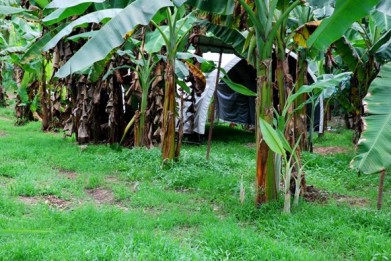
Integrating animal husbandry with fruits - here, free range chickens with bananas. There is no necessity to fertilise the fruit trees at all. Do not integrate durians with chickens.

Sematu is best - it has large leaves providing good shade, grows fast and is more hardy than 'improved' bananas like mas or berangan. The sematu above are young trees, barely three months old.

Free range chickens with mangosteen - here, hiding from the mid-day sun under the mangosteen fruit trees.
17:21 Posted in Permaculture | Permalink | Comments (2) | Tags: permaculture, free range chickens, sun shading, grey water treatment, integrated farming, permaculture examples, raised beds, companion planting, mulching, sheet mulching
Symbiotic Relationships - Ant-Hill Mushrooms
Now here's a sight for sore eyes, cendawan busut or ant-hill mushroom, termitomyces albuminosa.
The mushroom grows to the surface from the termite nest (above photo), which can be a foot (30cm) up. The entire stalk is edible and delicious.
It is one of the most delicious mushrooms, and leave ALL cultivated mushrooms miles behind in terms of taste and texture.
Unfortunately it is still not possible to cultivate this mushroom commercially. It is symbiotic with a certain termite, odontotermes spp.
The termites cultivate the mushroom by breaking down wooden material that the mushroom needs to grown on. There is speculation that the mushroom needs the dung of the termites too to grow. The termites in turn use the material decomposted by the mushroom as food.
This is called, Living Together.
11:07 Posted in Blog | Permalink | Comments (3) | Tags: cendawan busut, termitomyces albuminosa, odontotermes spp, symbiotic relationships
Apr 11, 2011
Oddity In The Forest
Came across this oddity hanging down from a vine in the forest.


A foot across and about 6 to 8 inches thick

It's leaves. Sorry about the focussing, it was quite windy.
18:22 Posted in Blog | Permalink | Comments (2) | Tags: unusual plants, rainforest, rare plants
Apr 08, 2011
Marcotting II
We generally have good root formation in around 30 to 45 days for lemon trees and other limau-type trees.
Saw off, and dap some iodine on the cut
Wrap vermicast around the root ball
Plant in a polybag with a light, friable and loose soil mix. We like to add some sand and vermicast to our farm soil. Loose, light soil will encourage the roots to grow deeper.
Cover the plant with a plastic bag to prevent drying out. Remove when new leaves and branch shoots are noticeable. Once the new leaves and shoots are established, plant to soil.
The area where we are planting these citruses have heavy laterite soil. We generally dig a hole and then mix the laterite with sand and compost.
We mix the laterite with sand and vermicast or compost
Place the plant half inside the hole
A planted marcotted guava
We generally place an used tire over the spot and top up the soil mix as need be. The tire reduces weeds, and prevent leachate of compost and vermicast.
Support the young tree. Marcotted trees tend to be shallow rooted and care must be taken during windy monsoon seasons.
5 year old marcotted lemon tree falling over after a night of heavy rain and strong winds. Marcotted trees have no tap root so should be supported even when matured in windy zones.
12:37 Posted in Blog | Permalink | Comments (0) | Tags: marcotting, air layering, lemon, organic farming, permaculture
Mar 21, 2011
Marcotting I
Marcotting or air layering is used in our farm to propagate fruit trees such as limau nipis, limau purut and lemon. We also use it to increase the numbers of any endangered tree we come across.
Matured lemon tree from marcotting
We have high success rates with the following method:
Have a clean cut on the chosen branch from the side of the tree facing the morning sun
Dusting with rooting powder helps speed up the process
Wrap with areca nut fiber that has been pre-soaked for an hour or so with boiled water
Wrap well with cling wrap
Finally wrap with aluminum foil
Keep the areca nut fiber continuously moist by injecting in boiled water once a week. Use a syringe. Inspect for root formation progress once a month.
Making areca nut fiber is easy.
Areca Palm ( areca catechu ) at the farm
Ripe areca nuts
Dry areca nuts
Peel open to expose the fiber
Fine areca nut fiber
Sterilise the fiber by soaking in a light iodine solution for an hour and then sun drying. The fiber will keep for months. The fiber can also be used to make ropes, be woven, etc. Remember to soak thoroughly when using for marcotting.
Next, how to poly bag it, and how to plant it in Marcotting II.
19:07 Posted in Blog | Permalink | Comments (0) | Tags: marcotting, air layering, areca nut, pokok pinang, areca palm, areca nut fiber








